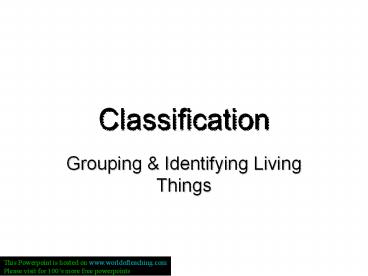Classification - PowerPoint PPT Presentation
1 / 36
Title:
Classification
Description:
Classification Grouping & Identifying Living Things This Powerpoint is hosted on www.worldofteaching.com Please visit for 100 s more free powerpoints – PowerPoint PPT presentation
Number of Views:106
Avg rating:3.0/5.0
Title: Classification
1
Classification
- Grouping Identifying Living Things
This Powerpoint is hosted on www.worldofteaching.c
om Please visit for 100s more free powerpoints
2
Taxonomy
- The study of how living things are classified
- Classification is the sorting of organisms based
on similar characteristics - Carolus Linnaeus is known as the Father of
Taxonomy
3
Levels of Classification
- Domain
- Kingdom
- Phylum
- Class
- Order
- Family
- Genus
- Species
- Dear
- King
- Phillip
- Came
- Over
- For
- Good
- Spaghetti
- Most General
- Most Specific
4
Genus and Species
- The last two levels make up an organisms
scientific name - This is called Binomial Nomenclature
- Bitwo
- NomialName
Acer grandidentatum
Penicillium chrysogenum
Felis Concolor
5
(No Transcript)
6
(No Transcript)
7
Classifying Living Things
- We put livings things into three Domains
- Eukaryota Bacteria Archaea
- Which are divided into 6 Kingdoms
- Plant Animal Fungi
- Protist Eubacteria Archaebacteria
- We are in the Domain Eukaryota and the Kingdom
Animalia
8
Prokaryotes no nucleus
Do have a nucleus
9
Animal Kingdom
- All animals are multi-cellular!
- All animal cells are eukaryotic!
- What does this mean?
- Their cells have a nucleus and membrane bound
organelles. - Animal cells are only surrounded by cell
membranesno cell wall! - Animals are heterotrophs
- Most animals can move
10
Animal Kingdom
- All animals have specialized parts that do
specific jobs. - Animals have different types of cells (ex. Heart
cell vs. brain cell) - Animals have different kinds of tissues for their
various organs. - The different organs in an animal perform
different jobs for the whole body.
11
Animal Kingdom
- Sowhat makes an animal an animal?
- Multicellular
- Heterotrophs
- Eukaryotes
12
Symmetry
- BilateralCan be divided into two mirror-images
halves - Radialmany lines of symmetry through a central
location
13
Animals
- Animals are spilt into two major groups
- Vertebrates
- Phylum Chordata
- Invertebrates
- Most animals are invertebrates
- 29 different Phyla
14
Vertebrates
- These are animals with a backbone.
- There are five groups of vertebrates
- Amphibians
- Birds
- Fish
- Mammals
- Reptiles
15
Endo or Ecto?
- Endothermic means their body temperature does not
change much, even when the temperature of the
environment changes. (Warm Blooded) - Mammals and Birds
- Ectothermic means their body temperature changes
with the environment. (cold blooded) - Fish, Amphibians, and Reptiles
16
Fish
- Have wet scales
- Lays eggs in water
- Lives in water
- Uses gills for breathing
- Ectothermic
17
Amphibians
- Have moist skin
- Obtains oxygen through lungs and skin
- Lay jelly coated eggs in water
- Lives on land and water
- Ectothermic
18
Reptiles
- Have dry scales
- Lay waterproof eggs on land
- Skin is adapted to keep water in the body
- Breaths through lungs
- Ectothermic
19
Birds
- Have feathers, scales on feet and legs and hollow
bones - Have a gizzard that holds small stones to help
grind food - Have a four chambered heart
- Lay hard shelled eggs
- Endothermic
20
Mammals
- Have hair or fur and produce milk
- Specialized teeth
- Give birth to live offspring (no eggs)
- Have a four chambered heart
- Endothermic
21
Summary of Vertebrates
22
Invertebrates
- These are animals without a backbone
- There are eight groups of invertebrates
- Mollusks
- Flatworms
- Segmented Worms
- Roundworms
- Sponges
- Echinoderms
- Cnidarians
- Arthropods
23
Sponges
- Filter feed
- Simplest Animals
24
Worms
- Bilateral symmetry
- Have head and tail ends
- Simplest organism with a brain
25
Flatworms
- Have flat worm like bodies
- Tapeworms and planarians
26
AnnelidsSegmented Worms
- Have bodies made up of many linked sections
- Earthworms
27
Roundworms
- Digestive system is like a tube open at both ends
- Have bodies with no segments
28
Arthropods
- Have
- segmented bodies
- Jointed appendages
- External skeleton
- There are four group of arthropods
- Arachnids
- Centipedes Millipedes
- Crustaceans
- Insects
29
Arthropods - Arachnid
- Have four pairs of legs.
- Have bodies divided into two sections
30
Arthropods Centipedes Millipedes
- Have long thin bodies and pairs of legs on each
of their many body sections
31
Arthropods - Crustacean
- Have five-seven pairs of legs
- First pair often used as pincers
- Bodies covered in shell
32
Arthropods - Insects
- Have three pairs of legs
- Bodies divided into three sections
- Often have wings
33
Mollusks
- Soft bodies, some have a hard outer shell, foot
for moving - Three Groups
- Gastropod-most diverse
- Bivalve
- Cephalopod
34
Cnidarians
- Have stinging tentacles
- Radial Symmetry
- Two body forms
- Medusa-the form during the movement stage of life
- Polyp- sessile (doesnt move)
35
Madusa Polyp
- Shaped like a bowl
- Shaped like a vase
36
Echinoderms
- Have radial symmetry
- Have spiny outer covering
- Have a water vascular system































